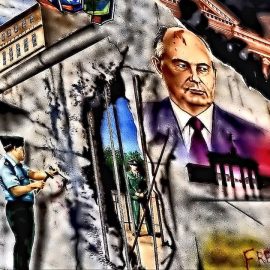

This article is an excerpt from the Shortform book guide to "The Autobiography of Malcolm X" by Malcolm X and Alex Haley. Shortform has the world's best summaries and analyses of books you should be reading.
Like this article? Sign up for a free trial here.
What do you know about Malcolm X? How did he rise to leadership? What legacy did he leave?
The Autobiography of Malcolm X as Told to Alex Haley explains how Malcolm X rose from a life of poverty and crime to become a significant leader in the civil rights movement. It provides insights into his fascinating life and explores how his beliefs changed over time.
Continue reading for an overview of The Autobiography of Malcolm X.
Overview of The Autobiography of Malcolm X
Malcolm X was a controversial figure—his views were often considered extreme, and they changed radically throughout his life. In telling his life story, Malcolm X explains why he believed what he believed—and why he fought stalwartly for racial justice, even though he knew it would lead to his death.
Published in 1965, The Autobiography of Malcolm X as Told to Alex Haley was written by Malcolm X and Haley. Haley was a journalist and author of the novel Roots, which later became a record-breaking television series. Haley recorded interviews with Malcolm X, minimally edited the transcripts, and compiled them into an autobiography—which means the autobiography is given in Malcolm X’s own words. (Shortform note: For that reason, we’ll refer to Malcolm X as the sole author until we discuss his death and legacy—information that Haley provided himself.)
- In Malcolm X’s Early Life Was Marred by Racism, we’ll explain how a childhood full of anti-Black racial terrorism and economic violence culminated with Malcolm X spending time as a young adult in prison.
- In The Nation of Islam Gave Malcolm X a Second Chance, we’ll discuss how and why Malcolm X converted to a unique brand of Islam and how his religion led him to become a civil rights activist.
- In A Pilgrimage to Mecca Opened Malcolm X’s Eyes, we’ll explore why Malcolm X left the Nation of Islam and how a visit to Mecca changed his religious and political views.
- In Malcolm X’s Death and Legacy, we’ll discuss the circumstances surrounding Malcolm X’s murder and his legacy.
Malcolm X’s Early Life Was Marred by Racism
Malcolm X believed that the racism he experienced throughout his childhood to adolescence determined the path he would take as an adult. We’ll explain how racist violence and structural inequality destabilized and discouraged a young Malcolm X—and ultimately led him to spend time in prison.
Racism Destabilized and Discouraged Him
Malcolm X explains that he was born Malcolm Little on May 19, 1925, in Omaha, Nebraska. (Shortform note: He eventually dropped “Little” and changed his name to Malcolm X, but we’ll still refer to him as Malcolm X.)
From the time he was born, his family was constantly being threatened by racists, in part because his father, Earl Little, was associated with Marcus Garvey’s Back-to-Africa movement, which argued that Black Americans must move to Africa to attain dignity and self-determination. As a result, the family moved often; eventually, they settled in Lansing, Michigan.
When Malcolm X was six, his father died, and the family suffered tremendously because Little had been the sole breadwinner and the Great Depression was on. His death was ruled a suicide, but his family and community believed racists had murdered him. The family received some welfare and Malcolm X’s mother, Louise Little, tried to work, but the racism she encountered made it hard for her to keep a job. She was multiracial and appeared white, but, when employers eventually found out that she was Black, they fired her. Malcolm X recalls that he began stealing food at this point.
Under incredible strain trying to keep the family together, Malcolm X’s mother struggled with her mental health and eventually became incapable of caring for her children. The state removed them and committed her to a psychiatric hospital. Upon reflection, Malcolm X believed that his mother lost her children and her mental health because the state didn’t give her enough help—and he asserts that this ordeal was equivalent to slavery since white people with greater social power ended up with custody of a Black woman’s children.
For a while, Malcolm X lived with a family he knew, but after he got into some trouble at school, he was expelled and sent to live at a juvenile detention facility run by white people, whom he says were nice but treated him as less-than-human because he was Black. He was enrolled in school where he was one of only a few Black students and was at the top of his class. However, one of his teachers told him that regardless of how intelligent and likable he was, he would never be able to attain a professional career because he was Black—he was only suited for manual labor. He explains that this made him feel discouraged and indignant about racism; as a result, he stopped putting in effort at school.
By this time, Malcolm X had already met his older sister Ella—his father’s daughter from a previous marriage—and stayed a summer with her in Roxbury (a neighborhood of Boston). This stay had a huge impact on him because Roxbury was a thriving Black cultural center—Malcolm X explains that it was the first time he was exposed to such a magnitude of Black success. After the incident with his teacher left him feeling defeated, he asked Ella if he could live with her—she agreed, and he moved there after eighth grade.
Racism Limited His Options to Crime
Ella encouraged Malcolm X to get to know the nice parts and people of Roxbury, but he was drawn to the ghetto. In the ghetto, he befriended a man named Shorty, who helped him get a job as a shoeshiner at a nearby ballroom. Eventually, he moved in with Shorty—partially because Malcolm X started dating a white girl named Sophia, which Ella didn’t like. He explains that hanging out with Shorty and his friends changed him in a few ways: He started to gamble, drink, and smoke cigarettes and marijuana. He also learned how to dress and talk as they did in the city.
Malcolm X had a few different jobs and eventually landed a gig as a cook on a train. At first, he excelled at this job because, he explains, he acted like an “Uncle Tom”—a Black person extremely devoted to serving white people. The train sometimes took him to Harlem, and the more time he spent there, the more he loved it and the more uninhibited he became in his interactions with white people. It showed in his work, and ultimately he was fired for being disrespectful to passengers. At 17, he moved to Harlem to work at a nightclub called Small’s Paradise.
From his customers at Small’s Paradise, Malcolm X learned more about Harlem’s history—how it came to be an all-Black area and why it seemed to cater to whites anyway (it was the Harlem Renaissance, a period of Black cultural enrichment, and white people enjoyed consuming Black entertainment). He also learned about the rules of hustling—making money through illicit means—from his customers, especially those few who were involved in the underground crime scene. Malcolm X explains that the criminals he knew became criminals because white society deprived them of the opportunity to fulfill their true potential—they turned to crime in order to survive, and they did drugs to help them deal with the pressure.
Malcolm X, too, would start committing crimes and doing drugs to get from day to day. For example, he says that he sold marijuana, got involved in the illegal gambling scene, and started doing cocaine so that he could steel himself for robbery. Over time, this began to catch up to him—he felt emotionally lifeless, and the drugs were making him sick. After an altercation with another hustler almost ended in violence and led him to go on a multi-drug-fueled bender, Shorty took him back to Boston.
After returning to Boston, Malcolm X decided to start a burglary ring involving Shorty, their friend Rudy, Malcolm X’s girlfriend Sophia, and her sister. Since the women were white, they could get into houses by pretending to have legitimate business there (like selling encyclopedias, for example), which Black men couldn’t do without arousing suspicion. When they left, they could tell the men how the house was set up and where there were any items worth stealing. Their burglary scheme was successful, but Malcolm X explains that he continued doing a lot of drugs to help him deal with his anxiety about being caught.
Eventually, they were caught—and Malcolm X was sentenced to eight to 10 years in prison at the age of 20, despite the average sentence for first-time burglary convictions being only two years. He explains that he believes part of the reason the penalty was so harsh was because he had gotten two white women (who were only sentenced to one to five years in prison) into trouble as well. The prison was dirty with no running water, he felt trapped like an animal, and he was often put in solitary confinement.
Upon reflection in later life, Malcolm X explains his belief that his imprisonment was inevitable—and that it was also inevitable for countless other Black youths. Since they were largely confined to overpoliced ghettos where crime was rampant, denied the opportunity to receive a good education or get good jobs, and able to get their hands on drugs that would numb the pain of their existence easily, Black people were more likely to engage in crime and get caught for it.
The Nation of Islam Gave X a Second Chance
While he was in prison, some of Malcolm X’s family converted to Islam—and they promised that they could help him get out of prison if he joined, too. We’ll discuss the unique teachings of the Islamic organization he joined. Then, we’ll explore how his involvement in this organization changed his life for the better, culminating in the beginning of his civil rights career.
The Nation of Islam’s Unique Teachings
The type of Islam Malcolm X’s family tried to convert him to was known as the Nation of Islam—a collection of teachings promoted by Elijah Muhammad (the Nation of Islam’s leader, who succeeded founder W.D. Fard), which posited that white people are the devil and that they’ve perpetrated evil against Black men by cutting them off from their ancestral cultures and convincing them of white superiority. Malcolm X explains that, according to this belief system, the different races were purposefully created by a scientist named Yacub through eugenic engineering, and the white race was supposed to rule the world for 6,000 years before Black people (who were the original and naturally superior race) would ascend to the top.
How Islam Changed Malcolm X’s Life
Malcolm X explains that he was prepared to accept these teachings as the truth because he knew that the way he had been living was wrong—this seemed a viable alternative. To convert, he first stopped smoking cigarettes and eating pork. He then wrote to Elijah Muhammad, who welcomed him to the religion and told him that he was living proof of white men’s devilish nature—since they deprive Black men like him of opportunities and force them to become criminals to survive. The two began to write to each other frequently, which is how Malcolm X learned more about the religion.
Muhammad’s teachings inspired Malcolm X to learn more about Black history and the histories of other people of color in the world, so he hit the prison library. He explains that Ella had gotten him transferred to a prison with better rehabilitative resources. He concluded that white men had used Christianity to oppress people of color around the globe and that Black people have a rich ancestral heritage to be proud of.
Invigorated by his new beliefs, Malcolm X started participating in the prison debate club, arguing in favor of Black superiority and proselytizing to receptive Black inmates. For the last year of his sentence, he was transferred back to the first prison he was incarcerated at—he explains that this was because the authorities deemed his outspokenness about his newfound pro-Black beliefs dangerous. However, he continued debating—and with time, his self-confidence grew.
Malcolm X notes that he was paroled in 1952, having served six years of his sentence, and began living with his family in Detroit. He joined the Nation of Islam’s temple there and was inspired by the local Black Muslim community’s high moral standards—standards which he felt kept them out of trouble and poverty, while non-Muslim Black people in America continued to languish. He also changed his last name from Little to X—a common practice in the Nation of Islam that signified the true ancestral surnames that had been stolen from Black people when they were enslaved.
Eventually, Malcolm X traveled to Chicago to meet Elijah Muhammad and, under Muhammad’s guidance, set to work recruiting new members and building the religion. He tripled temple membership in Detroit within a few months and went on to establish new temples in Boston, Philadelphia, Springfield, and Atlanta. Because of Malcolm X’s success, Muhammad named him head minister of Temple Seven in New York City.
At Temple Seven, Malcolm X met Betty, the woman who would become his wife. Although he didn’t want to be married because he felt that women were weak, troublesome, and in need of being controlled, he explains that he was inspired by Betty’s devotion to the religion and came to believe they were a good match.
How Malcolm X Became a Civil Rights Leader
Converting to the Nation of Islam didn’t just change the quality of Malcolm X’s life—it also radically transformed his politics, which led to his involvement in the civil rights movement. We’ll first discuss his political beliefs and then explain how he became an activist.
Malcolm X’s Political Beliefs
Malcolm X was critical of the American civil rights movement and its more moderate leaders—he felt that civil rights victories were negligible and that Black people shouldn’t be content to gain their freedom piece by piece. He also explains that he thought much of the movement, including the March on Washington (a civil rights protest led by Martin Luther King Jr.), was performative—it quieted discord but didn’t result in any meaningful changes, partially because it accepted white people’s money (and therefore influence) and sought white people’s approval. He was in favor of a more radical approach to Black liberation, and he believed that the Nation of Islam should participate in civil rights action in order to prove the efficacy of radicalism.
One part of this radical approach was Black separatism—Malcolm X believed that the races should be kept economically and culturally separated. He explains that he believed this because, in his eyes, integration did more harm than good for Black people: Black people wanted to be free of white people, who were uniformly evil, and to have a chance to form their own self-sufficient communities. He also believed that integration would necessarily lead to interracial marriage, which would produce multiracial children and ultimately destroy both races.
Another part of this radical approach was self-defense against racism, by way of violence if necessary. Male members of the Nation of Islam were enrolled in a program called the Fruit of Islam—the Nation of Islam’s security division—where they’d be trained in self-defense tactics like judo. Malcolm X believed that this was necessary because white people had continually perpetrated violence against Black people; furthermore, he explains that not only did he believe that Black people had a right to protect themselves, but also that it would be morally wrong for them not to defend themselves against white violence.
How Malcolm X Became an Activist
Malcolm X explains that he got his start in civil rights work when he led a resistance movement against police brutality. A Black Muslim man named Johnson Hinton had been attacked by New York police and taken into police custody. Accompanied by many members of the Fruit of Islam, Malcolm X demanded that Hinton be released for medical care. Hinton was finally taken to the hospital by ambulance, and the Black Muslims followed—and were joined by other Black people who were incensed by police brutality and excited by the possibility of organizing against it. Hinton had to have a steel plate put in his skull and sued the city, winning over $70,000—the debacle got a lot of publicity, making the Nation of Islam a household topic.
In 1959, a documentary about the Nation of Islam called The Hate That Hate Produced aired, broadcasting the organization’s radical views to the national stage for the first time—this catapulted Malcolm X to widespread recognition. He began visiting colleges as a much sought-after guest speaker; he also engaged in TV and radio debates to explain why Black separatism was necessary and to fight against accusations that he was inciting violence—in his view, he simply advocated resisting oppression. Because of the increased media attention, the Nation of Islam got more popular—and began to be surveilled by the government.
Malcolm X used his leadership skills to recruit more converts with the aim of uplifting Black people and uniting them against racism. He explains that initially, many converts to the religion were people who struggled with addiction. The Nation of Islam forbade all drug use, so when someone wanted to convert, they had to give up drugs—a difficult but health-promoting process. Once they had, they’d seek out drug addicts they’d known in their former lives and help them through the process of getting sober. As the organization grew, it began to recruit traditionally successful Black people, including Christians. The Nation of Islam was successful because it gave Black people a supportive community and proactively helped them through their struggles.
A Pilgrimage to Mecca Opened Malcolm X’s Eyes
Although the Nation of Islam helped turn Malcolm X into a successful civil rights activist, problems were brewing within the organization that he couldn’t abide by. We’ll explain why Malcolm X broke from the Nation of Islam and explore how his beliefs and civil rights work changed afterward.
Malcolm X’s Break From the Nation of Islam
Malcolm X gained prominence that other Nation of Islam leaders didn’t—and he explains that eventually, Elijah Muhammad became jealous of him. He made Malcolm X the first National Minister of the organization and praised him to his face; all the while, he told others Malcolm X was untrustworthy and that he’d betray the Nation of Islam. But Malcolm X came to know that Muhammad was the untrustworthy one: He’d been having adulterous affairs with his secretaries, who became pregnant and were harshly punished for it.
Eventually, some of those secretaries filed a paternity lawsuit against Muhammad, and Malcolm X spoke to them himself to discover the truth. He’d been hearing rumors about Muhammad’s adultery for years, but his respect for the man and dependence on his teachings had prevented him from believing them. After talking to the secretaries, he was convinced—but still loyal. He brought his concerns directly to Muhammad, who told him that he had only fulfilled a prophecy, and Malcolm X prepared other ministers to teach about prophecy fulfillment so that followers wouldn’t be upset by Muhammad’s guilt when word inevitably got out.
Their relationship would only end after President John F. Kennedy was killed. Muhammad told ministers not to comment on it—but Malcolm X did anyway, arguing that the assassination was a punishment for JFK’s wrongdoing. For his disobedience, Muhammad sentenced Malcolm X to 90 days of silence and alerted the news to the punishment. That made Malcolm X suspicious of him—and eventually, it became clear to him that Muhammad wanted him dead. Malcolm X explains that he felt more disturbed by Muhammad’s betrayal than by the threat of violence because he had been so devoted to Muhammad and the cause that he was willing to die for them—the fact that Muhammad would rather lie than come clean destroyed his faith.
Muhammad did indeed want Malcolm X dead—he assigned someone to kill him, but that person respected Malcolm X and told him about the plan instead. At that point, Malcolm X knew he had to give up on the Nation of Islam—but he wasn’t willing to give up on civil rights activism. He created his own organization called Muslim Mosque, Inc. (MMI), which he hoped would embrace Black people of all religions and lift them out of their plight. He notes that many members of the Nation of Islam left to join his organization.
Racial Harmony Among All Muslims
Malcolm X explains that he’d heard criticism that the Nation of Islam was not truly Islamic—and since he was still a firm believer in Islam, he decided he needed to learn more about the religion. Since all Muslims are required to make a pilgrimage to Mecca at least once in their lifetime if they’re able, Malcolm X decided to do so—he wanted to see for himself what Muslims were like in the Middle East.
During Malcolm X’s travels, he was continually surprised by how united Muslims in the Middle East were—it seemed that racism didn’t exist there, as people with all complexions and ethnic backgrounds treated each other with respect and dignity. All the pilgrims were spiritually equal, and that was all that mattered as they traveled to Mecca. This was the first time Malcolm X had experienced racial equality, and it bewildered and excited him to finally be treated as a human being by the general public.
Once Malcolm X got to Mecca, he was turned away—an admittance clerk wasn’t convinced he was a real Muslim, so he’d have to prove before a court that he was. In the meantime, he had to remain at the airport. Eventually, he called a friend of a friend—the son of a diplomat named Abd-Al-Rahman Azzam—who quickly had him released to his family’s home. The Azzams’ hospitality deeply touched Malcolm X—he explains that since they were white-complexioned, it caused him to rethink his beliefs about the supposedly inherent evil of white men. When he did go to court, he was declared a true Muslim, so he finally completed his pilgrimage to Mecca, continually wondering at the racial harmony he was finally experiencing.
Malcolm X says that, before he left Mecca, he wrote a letter to some of his family members, collaborators at the MMI, and the media about the impact his pilgrimage had made on his beliefs—signing the letter with a different name, El-Hajj Malik El-Shabazz. He explained that he now believed the spread of Islam was the only thing that could solve racism in the United States since the bonds of religious fellowship were stronger than racial differences could undermine. He also no longer believed that all white people were evil; instead, he believed that the next generation of white people would play a role in achieving racial unity.
After his pilgrimage was over, he traveled around the Middle East for a while. He discussed the plight of US racism with everyone who would listen—poor people and nobles, people of all colors, who were astonished, sad, and angry to hear about these conditions. He explains that this made him start thinking about how isolated from the rest of the non-white world Black Americans were—and how powerfully world-changing such international connections might be. This led him to venture to Africa.
Malcolm X’s Pan-Africanism
Malcolm X says that first, he traveled to Nigeria, where he made several public appearances to discuss Black liberation. In one address, he spoke on the necessity of including Black Americans in the pan-African movement—an initiative intended to unite people of African ancestry around the globe, no matter where they now lived. He also argued that free African nations should bring the issue of American racism to the United Nations’ attention. After Nigeria, he traveled to Ghana, where he was invited to speak to the Ghanaian parliament about the need for pan-Africanist support of Black Americans. Then, he traveled to Liberia, Senegal, and Morocco to learn more about how Black people lived across Africa.
The Organization of Afro-American Unity
When Malcolm X returned to the United States in the summer of 1964, race riots had begun popping up across the country—and he explains that the press was making him the scapegoat for these riots. In response, he told reporters that it was time for Black Americans to stop asking the government for equal rights—they needed to organize alongside African nations and make their case to the United Nations (UN).
However, the white press continued to paint Malcolm X as a violent instigator, since he continued to insist on Black people’s right to self-defense against racism. While he no longer believed that white people were inherently evil, he explains that he did believe that living in a racist society made them dangerously arrogant and hypocritical. They despised having to consider the possibility that racism was wrong—and that therefore they were wrong. And, while they had no problem using violence to accomplish genocide, slavery, discrimination, and the spread of Christianity, they insisted on nonviolence from non-white people who threatened their power worldwide.
He also established the Organization of Afro-American Unity (OAAU), whose goal was Black liberation and eventually racial harmony, which would be accomplished by means of pan-Africanism and Black nationalism. He believed that Black nationalism (which refers to Black people’s total self-governance) was necessary because before they could truly unite with white people, Black people first had to recognize and become confident in their own essential humanity. The OAAU was open to Black people only—he explains that one reason for this was his belief that progressive white people should focus on teaching other white people how to become nonviolent toward Black people.
Malcolm X’s Death and Legacy
Before Malcolm X had a chance to accomplish very much with his newfound beliefs and organization, he was murdered in front of his family and community. We’ll explore the circumstances around his death and discuss his legacy.
Malcolm X explains that from a young age, he believed he would die a violent death—partly because that had happened to his father and other men in his family. Now that he’d left the Nation of Islam and begun making headway as a civil rights activist, he was even more convinced that someone would kill him.
Co-author Alex Haley explains that, although Malcolm X expected to die before his autobiography was published, Malcolm X continued to work on it because he wanted people to understand racism and how he’d tried to combat it. Malcolm X also predicted that white people would continue to associate him with hatred long after he was dead—because if they could write him off as hateful and violent, they’d never have to confront their own hatred and violence.
Haley says that, in the weeks before his death, Malcolm X told him that he believed the Nation of Islam was going to kill him, as agents of the group had been following him everywhere. When his house was firebombed one night, endangering his entire family, he publicly claimed that it was the Nation of Islam’s doing. However, he later told Haley that he wasn’t sure it was the Nation of Islam. Up to the day of his death, Malcolm X received disturbing phone calls and perceived threats all around him.
Haley explains that on February 21, 1965, Malcolm X was to give a speech to the OAAU at the Audubon Ballroom in Manhattan, New York. After he started speaking, there was a commotion—and suddenly, he was shot. His wife and children were in the audience—she covered their children with her own body, then she hurried to the stage to try to save him. He was rushed to the hospital, but it appeared that he was already dead by his arrival.
According to Haley, the police ultimately arrested and indicted three members of the Nation of Islam for Malcolm X’s murder—Talmadge Hayer, Norman Butler, and Thomas Johnson.
Haley notes that Malcolm X remained controversial in death—although masses of people attended his funeral, the proceedings were also plagued by bomb threats, and his family had trouble finding somewhere to hold the funeral. Ultimately, they were accepted by the Faith Temple, Church of God in Christ, and Malcolm X was buried in Ferncliff Cemetery in Ardsley, New York.

———End of Preview———
Like what you just read? Read the rest of the world's best book summary and analysis of Malcolm X and Alex Haley's "The Autobiography of Malcolm X" at Shortform.
Here's what you'll find in our full The Autobiography of Malcolm X summary:
- Malcolm X explains why he believed what he believed
- The historical and sociological context surrounding Malcolm X’s life
- Why Malcolm X was such a controversial figure






